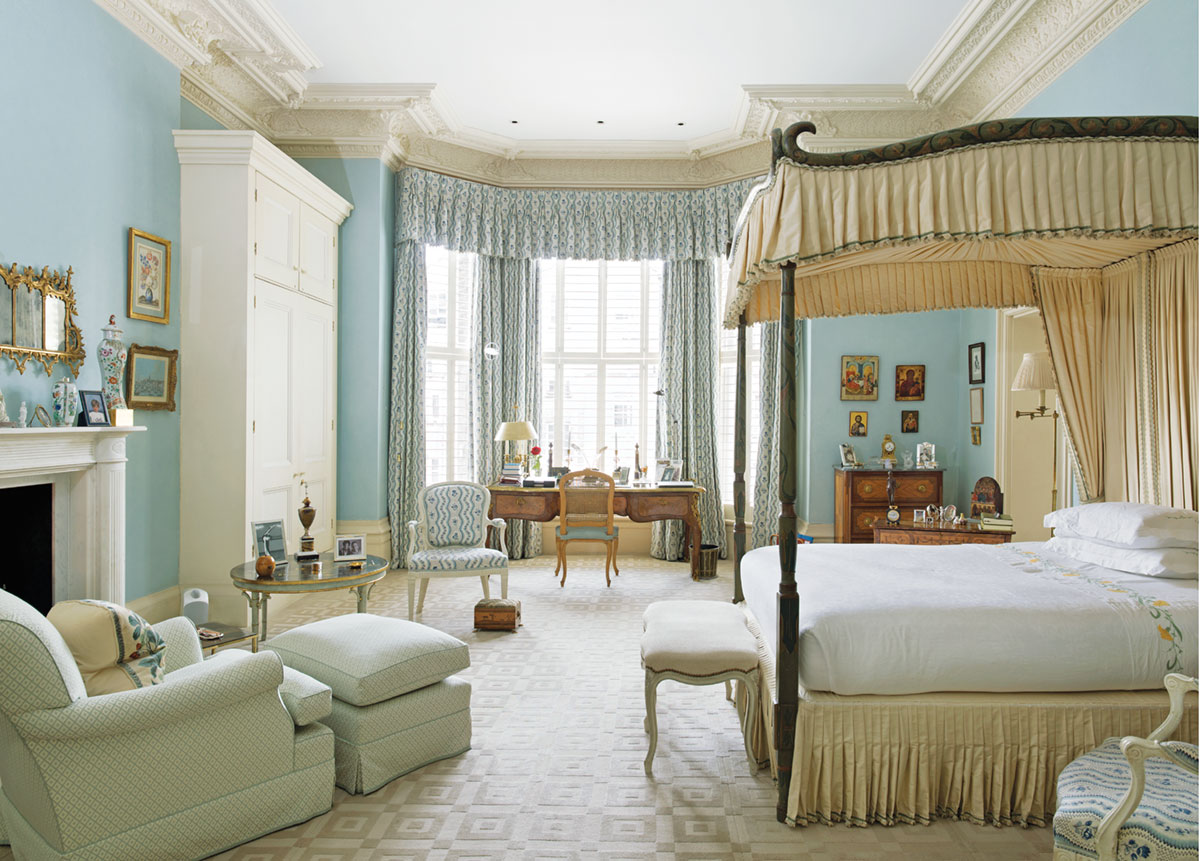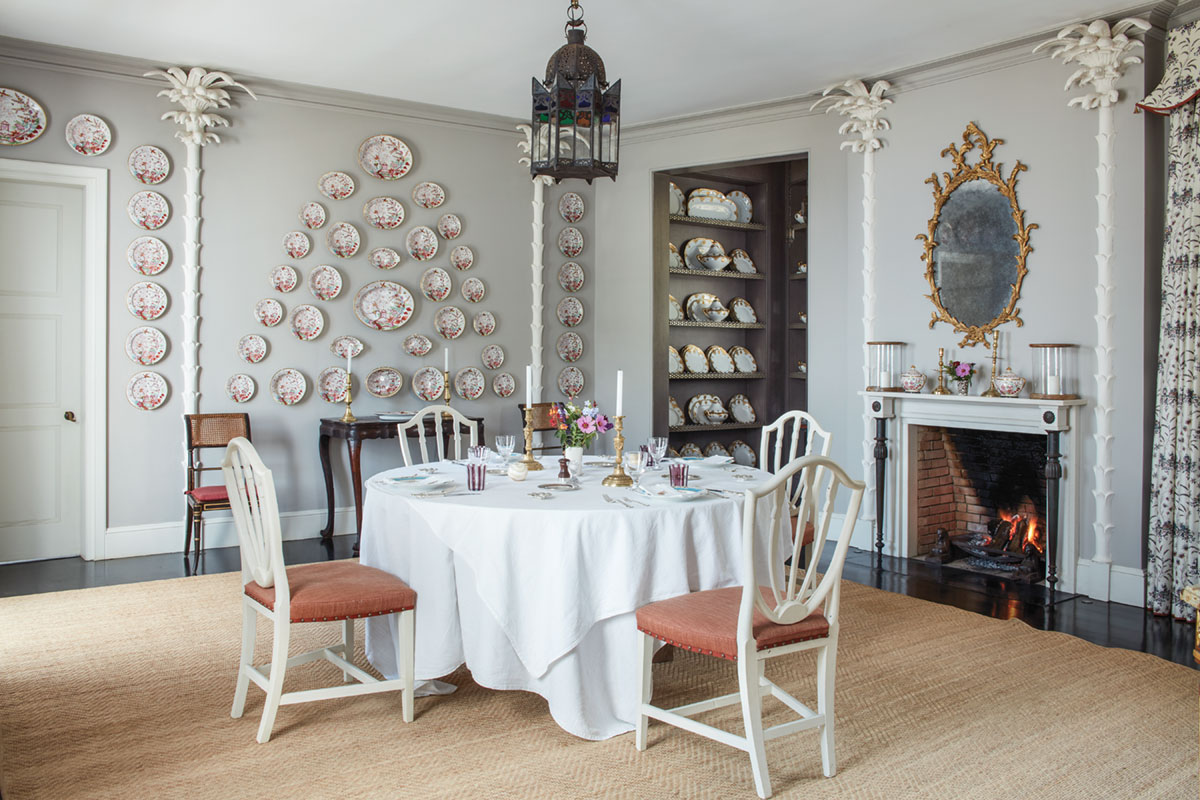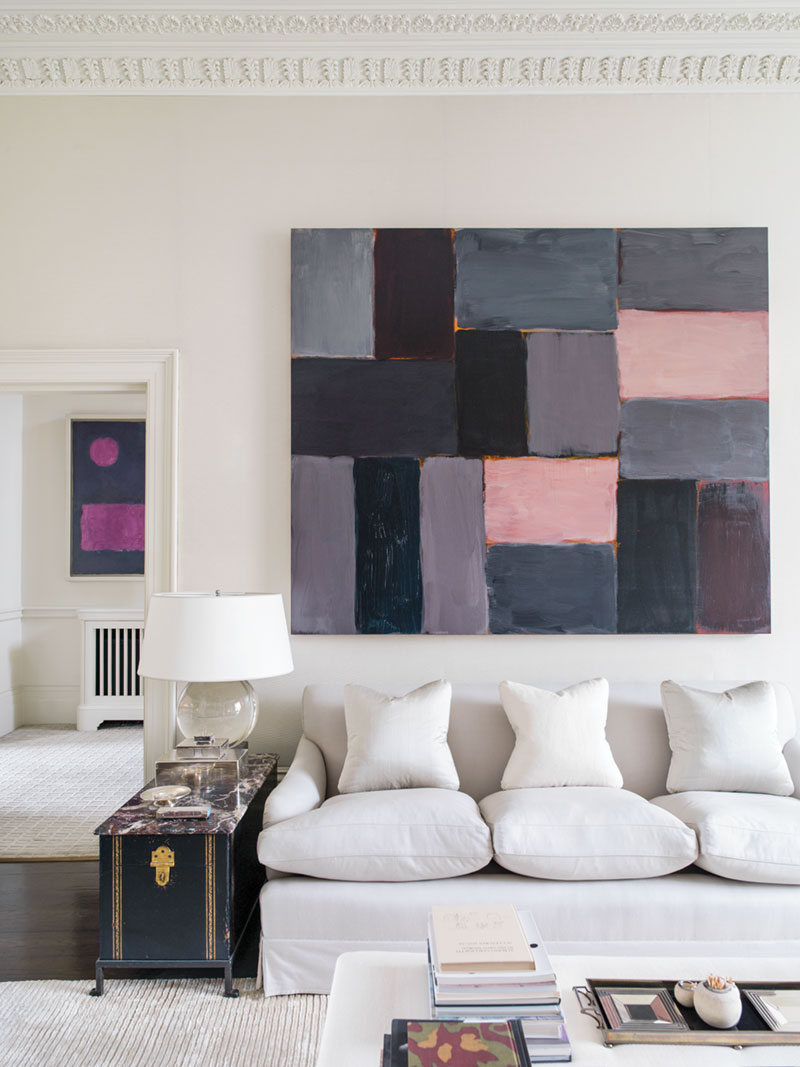
Small seating groups foster intimacy in a grand drawing room.
Q&A
Flower: Your background is fascinating! Before becoming a world-class decorator, you were a self-described hippie?
Veere Grenney: For me, there wasn’t a clear path to decorating. Since I’ve gotten older, it’s hard to remember exactly what I wanted to do in my life or where I wanted to do it, but I knew it would involve houses and travel. I was born and raised in Auckland, New Zealand, and, in the world that I came from, you couldn’t pursue an education in decoration like you could in America. You either got a degree in the history of art or a similar subject or you sought an apprenticeship, which is what I ultimately did.
So how did you know you wanted a career in design when you had such little exposure to it?
As a boy, I was always rearranging the furniture in my family home and studying the American decorating magazines of the 1960s. I found them so intriguing, particularly those with floor plans, as so many had at the time. My parents were both British, so I grew up rooted in their traditions. I always envisioned myself living in London one day. In the 1970s, after leaving school and working for a few years, I did. You could say it took me a little while to get there.

Interior decorator and author Veere Grenney

A Bridget Riley painting hangs above an Art Deco table and a Jean-Michel Frank stool.
You definitely did not take the most direct route. I loved reading about your journey along the Hippie Trail in your 2018 book, Veere Grenney: A Point of View. En route to London, you traveled through Nepal, India, Afghanistan, and Morocco. I believe there were a few more places in between, too.
That was a very profound period in my life. I was lucky to have those experiences because they gave me entrée to a bigger world than I would have known had I stayed in New Zealand or gone straight to England. When you spend time in different places and absorb those cultures, you free yourself from the conventions and restraints that a strong society ties you to.

A formal guest room at a countryside estate

The lush courtyard loggia at Gazebo, Veere’s home in Tangier, Morocco, offers shade and sweeping views of the Gibraltar Strait

The cozy library at Maison Cooq, the 19th-century villa in Tangier that Veere leased during the three-year construction of Gazebo
As I understand it, it was through antiques dealing that you met Mary Fox Linton and were recruited to work in the showroom she shared with David Hicks.
Yes. Mary used to buy from me, and we had a beautiful relationship. In the early 1980s, she asked me to come work at her very avant-garde showroom. She became my mentor and taught me how to organize projects, make estimates, and those sorts of things. After 17 years with her, I went out on my own, and that’s when I was discovered by Colefax and Fowler.
Besides the international name recognition, what appealed to you about working at the firm? Their look was so traditional, while yours was more modern and edgy.
When I went out on my own, I was in a relationship with a well-known decorator, and we shared office space. He introduced me to what I call the “grand English style” that was very much in line with the John Fowler school of decoration. I understood it well even though my style was more contemporary. It turns out that was what they were looking for.

The dining room at Gazebo exudes a proper English aesthetic, while a Moorish lantern and Syrie Maugham–style palm tree pilasters reflect the local color.
When you left the firm after 15 years, what did you leave with?
I left with a greater appreciation and knowledge of tailoring, particularly couture curtaining. That’s extremely important in high design, and they were the experts.
What did you leave with them?
A new way of thinking. That classic and contemporary can actually complement one another.

Shades of gray and black temper the punchy pinks in a painting by Sean Scully.

Veere Grenney: A Point of View by Veere Grenney (Rizzoli New York, 2018)
Aside from your former colleagues, who else influenced your work?
Billy Baldwin, David Hicks, and Nancy Lancaster. I learned about Billy Baldwin when I was around 12 years old, and I thought he was the greatest thing since sliced bread. As an American, he was more in tune with apartment living, whereas Lancaster and Hicks understood the English idiom.
And what is that idiom to you?
That a beautiful house has to be supported by a beautiful garden. Otherwise, what’s the point? There is something so delicious about freshly picked vegetables and flowers from your own garden. I don’t think you could wish for anything more in life.

A bedroom wrapped in Belvedere wallpaper from Veere’s eponymous collection.
Tell me about your gardens.
The garden at my country house, The Temple, is very formal. I have kitchen and rose gardens, formal gardens and trees, fruit orchards, and a crisp lawn. It’s pleasing from every angle because you can see the water to one side and the Palladian architecture of the home to the other. At Gazebo, my new holiday house in Tangier, there is an enormous terrace where you can look out and see Portugal and southern Spain. It has the same climate as Auckland—mild winters and dry summers. I have palm trees, aloes, and other tropical vegetation, plus a formal English garden; a pomegranate orchard; a courtyard; and lots of gardenias, petreas, begonias, and hollyhocks.
Sounds heavenly! Have your gardens inspired your interior design?
Absolutely. I often use botanicals in my work, and there are several in my fabric and wallpaper collections. We have a classic English chintz that we pair with geometric patterns for a less fussy look. We also have a new collection coming out with Schumacher that includes many florals, but they are abstract by design, and I think that makes them more interesting.
Interior design by Veere Grenney, Veere Grenney Associates, veeregrenney.com, Instagram @veere_grenney
This book review originally appeared in Flower magazine’s May/June 2021 issue. Find Flower in a store near you or subscribe.
On the Cover: In a garden by landscape architect Quincy Hammond, a bench based on Beatrix Farrand’s drawings for the Rose Bench at Dumbarton Oaks sits on an axis through the cutting garden, beneath red-leaved Norway maples. Photo by Lauren Coleman. See story.




